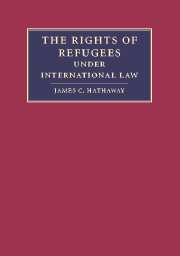Book contents
- Frontmatter
- Contents
- Acknowledgments
- Table of cases
- Table of treaties and other international instruments
- Abbreviations for courts and tribunals cited
- Introduction
- 1 International law as a source of refugee rights
- 2 The evolution of the refugee rights regime
- 3 The structure of entitlement under the Refugee Convention
- 4 Rights of refugees physically present
- 5 Rights of refugees lawfully present
- 6 Rights of refugees lawfully staying
- 7 Rights of solution
- Epilogue: Challenges to the viability of refugee rights
- Appendices
- Select bibliography
- Index
2 - The evolution of the refugee rights regime
Published online by Cambridge University Press: 06 January 2010
- Frontmatter
- Contents
- Acknowledgments
- Table of cases
- Table of treaties and other international instruments
- Abbreviations for courts and tribunals cited
- Introduction
- 1 International law as a source of refugee rights
- 2 The evolution of the refugee rights regime
- 3 The structure of entitlement under the Refugee Convention
- 4 Rights of refugees physically present
- 5 Rights of refugees lawfully present
- 6 Rights of refugees lawfully staying
- 7 Rights of solution
- Epilogue: Challenges to the viability of refugee rights
- Appendices
- Select bibliography
- Index
Summary
The origins of refugee rights are closely intertwined with the emergence of the general system of international human rights law. Like international human rights, the refugee rights regime is a product of the twentieth century. Its contemporary codification by the United Nations took place just after the adoption of the Universal Declaration of Human Rights, and was strongly influenced by the Declaration's normative structure.
In a more fundamental sense, though, the refugee rights regime draws heavily on the earlier precedents of the law of responsibility for injuries to aliens and international efforts to protect national minorities. This chapter highlights the conceptual contributions made by each of these bodies of international law to the emergence of specific treaties to govern the human rights of refugees. It then introduces the essential structure of the 1951 Refugee Convention, still the primary source of refugee-specific rights in international law. Finally, this chapter takes up the question of the relationship between the refugee rights regime and subsequently enacted treaties, particularly those that establish binding norms of international human rights law. The view is advanced that refugee rights should be understood as a mechanism by which to answer situation-specific vulnerabilities that would otherwise deny refugees meaningful benefit of the more general system of human rights protection. Refugee rights do not exist as an alternative to, or in competition with, general human rights. Nor, however, has the evolution of a broad-ranging system of general human rights treaties rendered the notion of refugee-specific rights redundant.
- Type
- Chapter
- Information
- The Rights of Refugees under International Law , pp. 75 - 153Publisher: Cambridge University PressPrint publication year: 2005



